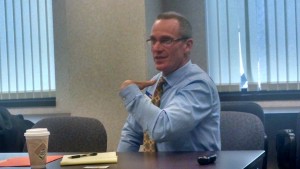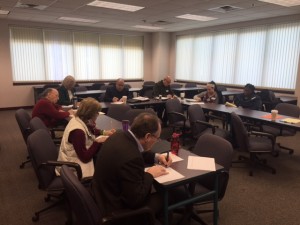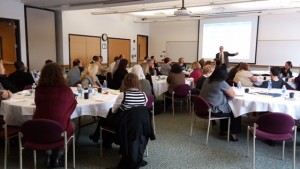by Dr. John Draeger, SUNY Buffalo State
I gave two workshops on metacognition this week — one to a group of business professiona ls associated with the Organizational Development Network of Western New York and the other to faculty at Genesee Community College. Both workshops began with the uncontroversial claim that being effective (e.g., in business, learning, teaching) requires finding the right strategy for the task at hand. The conversation centered around how metacognition can help make that happen. For example, metacognition encourages us to be explicit and intentional about our planning, to monitor our progress, to make adjustments along the way, and to evaluate our performance afterwards. While not a “magic elixir,” metacognition can help us become more aware of where, when, why, and how we are or are not effective.
ls associated with the Organizational Development Network of Western New York and the other to faculty at Genesee Community College. Both workshops began with the uncontroversial claim that being effective (e.g., in business, learning, teaching) requires finding the right strategy for the task at hand. The conversation centered around how metacognition can help make that happen. For example, metacognition encourages us to be explicit and intentional about our planning, to monitor our progress, to make adjustments along the way, and to evaluate our performance afterwards. While not a “magic elixir,” metacognition can help us become more aware of where, when, why, and how we are or are not effective.
As I prepared for these two workshops, I decided to include one of my favorite metacognition resources as a key part of the workshop. Kimberly Tanner (2012) offers a series of questions that prompt metacognitive planning, monitoring, and evaluation. By way of illustration, I adapted Tanner’s questions to a familiar academic task, namely reading. Not all students are as metacognitive as we would like them to be. When asked to complete a reading assignment, for example, some students will interpret the task as turning a certain number of pages (e.g., read pages 8-19). They read the words, flip the page, and the task is complete when they reach the end. Savvy students realize that turning pages is not much of a reading strategy. They will reflect upon their professor’s instructions and course objectives. These reflections can help them intentionally adopt an appropriate reading strategy. In short, these savvy students are engaging in metacognition. They are guided by Tanner-style questions in table below.
Table: Using metacognition to read more effectively (Adapted from Tanner, 2012)
| Task | Planning | Monitoring | Evaluating |
| Reading | What do I already know about this topic?
How much time do I need to complete the task? What strategies do I intend to use? |
What questions are arising?
Are my strategies working? What is most confusing? Am I struggling with motivation or content? What other are strategies are available? |
To what extent did I successfully complete the task?
To what extent did I use the resources available to me? What confusions do I have that still need to be clarified? What worked well? |
| Big picture | Why is it important to learn this material?
How does this reading align with course objectives? |
To what extent has completing this reading helped me with other learning goals? | What have I learned in this course that I could use in the future? |
After considering the table with reference to student reading, I asked the business group how the table might be adapted to a business context. They pointed out that middle managers are often flummoxed by company initiatives that either lack specificity or fail to align with the company’s mission and val ues. This is reminiscent of students who are paralyzed by what they take to be an ill-defined assignment (e.g., “write a reflection paper on what you just read”). Like the student scrambling to write the paper the night before, business organizations can be reactionary. Like the student who tends to do what they’ve done before in there other classes (e.g., put some quotations in a reflection paper to make it sound fancy), businesses are often carried along by organizational culture and past practice. W hen facing adversity, for example, organizational structure often suggests that doing something now (anything! Just do it!) is preferable to doing nothing at all. Like savvy students, however, savvy managers recognize the importance of explicitly considering and intentionally adapting response strategies most likely to further organizational goals. This requires metacognition and adapting the Tanner-style table is a place to start.
ues. This is reminiscent of students who are paralyzed by what they take to be an ill-defined assignment (e.g., “write a reflection paper on what you just read”). Like the student scrambling to write the paper the night before, business organizations can be reactionary. Like the student who tends to do what they’ve done before in there other classes (e.g., put some quotations in a reflection paper to make it sound fancy), businesses are often carried along by organizational culture and past practice. W hen facing adversity, for example, organizational structure often suggests that doing something now (anything! Just do it!) is preferable to doing nothing at all. Like savvy students, however, savvy managers recognize the importance of explicitly considering and intentionally adapting response strategies most likely to further organizational goals. This requires metacognition and adapting the Tanner-style table is a place to start.
When I discussed the Tanner-style table with the faculty at Genesee Community College, they offered a wide-variety of suggestions concerning how the table might be adapted for use in their courses. For example, some suggested that my reading example presupposed that students actually complete their r eading assignments. They offered suggestions concerning how metacognitive prompts could be incorporated early in the course to bring out the importance of the reading to mastery of course material. Others suggested that metacognitive questions could be used to supplement prepackaged online course materials. Another offered that the he sometimes “translates” historical texts into more accessible English, but he is not always certain whether this is good for students. In response, someone pointed out that metacognitive prompts could help the faculty member more explicitly formulate the learning goals for the class and then consider whether the “translated” texts align with those goals.
eading assignments. They offered suggestions concerning how metacognitive prompts could be incorporated early in the course to bring out the importance of the reading to mastery of course material. Others suggested that metacognitive questions could be used to supplement prepackaged online course materials. Another offered that the he sometimes “translates” historical texts into more accessible English, but he is not always certain whether this is good for students. In response, someone pointed out that metacognitive prompts could help the faculty member more explicitly formulate the learning goals for the class and then consider whether the “translated” texts align with those goals.
In both business and academic contexts, I stressed that there is nothing “magical” about metacognition. It is not a quick fix or a cure-all. However, it does prompt us to ask difficult and often uncomfortable questions about our own efficacy. For example, participants in both workshops reported a tendency that all of us have to want to do things “our own way” even when this is not most effective. Metacognition puts us on the road towards better planning, better monitoring, better acting, and better alignment with our overall goals.
Thinking about thinking in both business and academic environments Share on X
References
Tanner, K. D. (2012). Promoting student metacognition. CBE-Life Sciences Education, 11(2), 113-120.